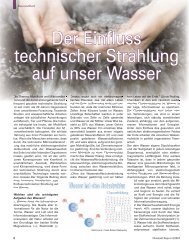U. S. Senate Minority Report: - Klimaforschung
U. S. Senate Minority Report: - Klimaforschung
U. S. Senate Minority Report: - Klimaforschung
Create successful ePaper yourself
Turn your PDF publications into a flip-book with our unique Google optimized e-Paper software.
discussion -- not have fixed mindset about global warming,” he said to applause from the<br />
members. (LINK) (LINK) [Note: The International Geological Congress prominently<br />
featured the voices and views of scientists skeptical of man-made global warming<br />
fears. See Full report here: & See: Skeptical scientists overwhelm conference: '2/3 of<br />
presenters and question-askers were hostile to, even dismissive of, the UN IPCC' ]<br />
Analytical chemist and mathematician Sherwood Thoele rejected the “consensus” view<br />
of man-made global warming in 2008. “I submit that there is no manmade global<br />
cooling/warming, that there is no study or research data that makes a good argument to that<br />
effect when carefully examined objectively and that the Earth has many different and wideranging<br />
cycles that man cannot control, no matter how much he would like to,” Thoele<br />
wrote on May 19, 2008 in Virginia's Roanoke Times. “As an analytical chemist, I analyze<br />
all the parameters and data from studies: what prompted the study, who funded it, where it<br />
was conducted, measuring equipment accuracy and the atmospheric conditions or physical<br />
status of that area during the study,” Thoele wrote. “Because CO2 is slightly soluble in<br />
water and will come back to the Earth with precipitation, nature corrects for any excess,<br />
just as it does with other excess materials from volcanoes and forest fires. CO2 comes from<br />
burning or oxidizing organic material and minerals that contain carbon. Major sources are<br />
fermenting (rotting) vegetation like in swamps, compost piles, burning limestone to make<br />
lime, gasoline or other petroleum products, volcanoes and forest fires. Nature recycles all<br />
of what it considers excess very efficiently. CO2 absorbs some infrared radiation. Infrared<br />
absorbers accept the radiation from any direction. Since infrared radiation is one of many<br />
parts of visible light, the biggest source is the sun,” Thoele explained. “Some say excess<br />
CO2 combined with the moisture in the atmosphere absorbs infrared radiation from the<br />
Earth to create a greenhouse effect by not letting it pass through it. But how then does the<br />
infrared radiation from the sun get through the CO2/moisture, and wouldn't it already have<br />
absorbed as much infrared radiation as it could handle from the sun? There is a limit to the<br />
amount of infrared radiation that moisture/CO2 can absorb. Warmth from sunlight means<br />
infrared radiation is getting through. The infrared radiation absorbed by the Earth will keep<br />
it warm for a while, but as clouds linger and the sun goes down, the warmth goes away<br />
quickly. So if there were a greenhouse effect from heat being blocked from leaving the<br />
Earth, then the temperature on cloudy days and at night shouldn't be so different than on a<br />
sunny day. Some claim a 1 degree Fahrenheit increase in the average temperature over the<br />
last 100 years, globally. Considering the many variables that cause temperature changes,<br />
including the accuracy of the thermometers, the average global temperature has been<br />
extremely stable in this short period of time relative to the age of the Earth,” he added.<br />
(LINK) & (LINK)<br />
Award-winning ecologist and evolutionary biologist Dr. Perry Ong is the director of<br />
the Institute of Biology at the University of the Philippines’ College of Science. Ong,<br />
who was awarded the Outstanding Young Scientist award by the National Academy<br />
of Science and Technology in 2000 and is a former representative of Conservation<br />
International, cited former Vice President Al Gore’s errors and called man-made climate<br />
fears “hyped up” in 2008. “Climate change has become a convenient excuse when there are<br />
other [environmental] issues that need to be addressed,” Ong said, according to a May 18,<br />
2008, article in the Philippine Daily Inquirer. “If we disproportionately blame ourselves for<br />
[climate change], our response will be different … we should look at the [bigger picture]<br />
and address other issues,” Ong said during a lecture called “Anthropogenic Global<br />
40





